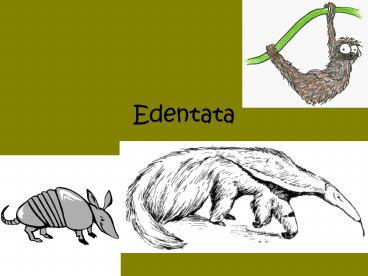Edentata - PowerPoint PPT Presentation
1 / 26
Title: Edentata
1
Edentata
- Notes only!!!
2
Edentata
- This order is also known as Order Xenarthra.
- Edentata means without teeth.
- Members of this order include armadillos, sloths,
and anteaters.
3
Armadillo
- Armadillos are very timid animals.
- They can jump over 3 feet straight up in the air.
- They are often run over by cars.
- Armadillos have a carapace, much like turtles.
- It covers most of the body.
- It is made up of bony plates covered with
epidermal scales. - This covering varies from a complete protective
covering when animals roll into a ball, to a more
loose-fitting one that does not completely cover.
- The carapace is attached to the skeleton by
muscles and ligaments. - It is not directly attached to the skeleton.
4
Armadillo
- Armadillos have very sparse hair.
- They do have teeth, but have no incisors or
canines. - Their teeth are shaped like cylinders and they do
not have any roots. - Most armadillos are terrestrial and are very
well-equipped for digging. - They eat insects and insect larvae.
- Occasionally, they will eat plants, eggs, or
fruit.
5
Sloth
- There are 2 families of sloth 3-toed and
2-toed. Characteristics are very similar for both
families. - Sloths are arboreal.
- This means they are tree-dwellers and have great
difficulty moving on the ground. - They often move upside-down on the underside of
branches. - They are nocturnal and sleep about 15 hours a
day.
6
Sloth
- Sloths are very long-limbed.
- Their forelimbs are longer than their hindlimbs.
- Sloths are also syndactyl, which means that their
toes are fused together. - Their cervical vertebrae vary in number, from
6-9. - Sloths do have teeth, but no incisors or canines.
- The teeth are shaped like cylinders, have no
roots, and are homodontic. - Sloths have long, coarse hair on which blue-green
algae grows.
7
(No Transcript)
8
Sloth
- They are herbivores and will eat buds, flowers,
and fruit. - Sloths have a very, very slow metabolism and very
poor temperature regulation. - The harpy eagle and the jaguar are the main
predators of sloths. - The sloths main defense is to nip and claw at
its attacker. - Being camouflaged is also a good defense.
9
(No Transcript)
10
Anteater
- Anteaters have a very long, tubular rostrum, or
snout. - Their mouth is very small.
- They have a long, sticky tongue that moves very
quickly. - This tongue will flicke in and out about 160
times per minute. - They do not have teeth.
- Anteaters are insectivores.
- They crush insects with their thickened stomach.
- They have large front claws for opening up
termite mounds, tearing up rotting logs, etc. - These long claws curl under while the anteater
walks on its knuckles. - Anteaters are solitary.
- They have terrible eyesight but a great sense of
smell.
11
(No Transcript)
12
(No Transcript)
13
(No Transcript)
14
(No Transcript)
15
(No Transcript)
16
(No Transcript)
17
(No Transcript)
18
(No Transcript)
19
(No Transcript)
20
(No Transcript)
21
(No Transcript)
22
(No Transcript)
23
(No Transcript)
24
Armadillo Scientific Name
- Dasypus novemcinctus (9-Banded Armadillo)
25
Sloth Scientific Name
- Bradypus variegatus (Brown-throated 3-toed Sloth)
26
Anteater Scientific Name
- Myrmecophaga tridactyla (Giant Anteater)

